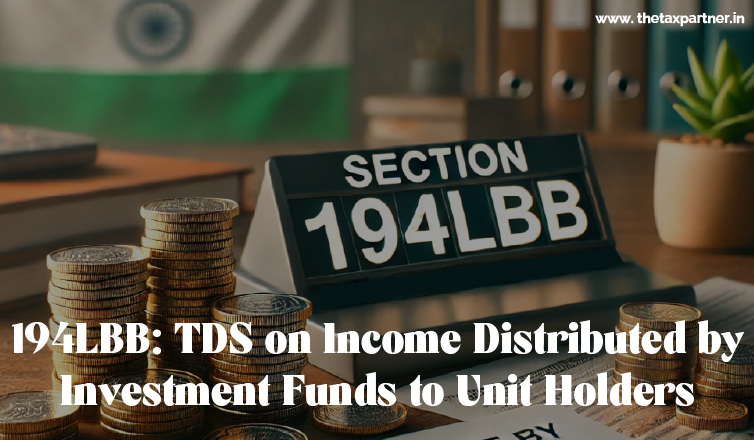Connect with us for all your queries



Introduction
Section 194LBB of the Income Tax Act, 1961, is a provision that deals with the deduction of tax at source (TDS) on income distributed by investment funds to their unit holders. The section is applicable to income distributed by a Category I or Category II Alternative Investment Fund (AIF) to its unit holders.
This article delves into the intricacies of Section 194LBB, outlining when the tax is to be deducted, the rates of TDS applicable to both resident and non-resident unit holders, and the meaning of key terms as per the Income Tax Act.
Applicability and Timing of TDS Deduction
Section 194LBB mandates that TDS is to be deducted when income is paid or credited, whichever is earlier. This means that if the income is credited to the account of the unit holder or is paid out in cash, by cheque, draft, or any other mode, the responsibility to deduct TDS arises at that point.
The law specifically states that even if the income is credited to a "suspense account" or by any other name in the books of accounts, it will be deemed as income credited to the unit holder’s account, and TDS must be deducted accordingly. This ensures that the income does not escape the tax net merely because it has not been directly credited to the unit holder's main account.
Rate of TDS under Section 194LBB
The rate of TDS under Section 194LBB varies based on the residential status of the unit holder:
It is important to note that under Section 194LBB, the option to apply for a lower TDS rate through Section 197 is not available. This means that all unit holders, whether resident or non-resident, are subject to the statutory rates without any scope for reduction.
Meaning of Key Terms
The application of Section 194LBB hinges on the understanding of certain key terms defined under the Income Tax Act:
Special Provisions for Income Exempt Under Section 10(23FBB)
Income referred to under Section 10(23FBB) is exempt from tax, and therefore, Section 194LBB does not apply to such income. Specifically, Section 10(23FBB) covers any income accruing or arising to, or received by, a unit holder of an investment fund, being that proportion of income which is of the same nature as income chargeable under the head "Profits and gains of business or profession."
In simple terms, if the income distributed by the investment fund is exempt under Section 10(23FBB), the fund is not required to deduct TDS on such income. This exemption primarily applies to income that aligns with business profits.
Practical Implications and Compliance
For investment funds and unit holders, Section 194LBB imposes a compliance requirement that must be carefully managed. The fund, acting as the deductor, must ensure accurate deduction of TDS at the appropriate rates and timely deposit of the same with the government.
For unit holders, particularly non-residents, understanding the implications of TDS on their distributed income is crucial. Non-resident unit holders must factor in the rates prescribed under the Act and consider the impact of surcharges and cess on their net income.
The strict requirement that tax cannot be deducted at a lower rate, even if the unit holder applies for a reduction under Section 197, adds a layer of rigidity to the compliance process. Investment funds must be vigilant in applying the correct rates and ensuring compliance with the provisions to avoid penalties.
Impact of TDS under Section 194LBB
Consider an Indian AIF that has several unit holders, both resident and non-resident. The fund distributes income of INR 10 lakhs to a resident unit holder and INR 15 lakhs to a non-resident unit holder (not being a company).
The deduction of TDS at source, particularly for non-residents, significantly reduces the amount of cash flow from the investment. However, non-residents can potentially claim a refund or adjust the TDS against their final tax liability, depending on their total income and applicable tax treaties.
Conclusion
Section 194LBB is a critical provision for ensuring that income distributed by investment funds to unit holders does not escape the tax net. The section applies stringent rules on the timing and rate of TDS deduction, with clear guidelines for both resident and non-resident unit holders.
For investment funds, adherence to these provisions is essential to maintain compliance and avoid potential penalties. Unit holders, on the other hand, must be aware of the implications of TDS on their distributed income and plan accordingly.
Understanding the nuances of Section 194LBB can help both investment funds and unit holders navigate the complexities of income distribution and taxation, ensuring that all parties fulfill their tax obligations while optimizing their financial outcomes.
Tax Partner is India’s most reliable online business service platform, dedicated to helping you in starting, growing, & flourishing your business with our wide array of expert services at a very affordable cost.